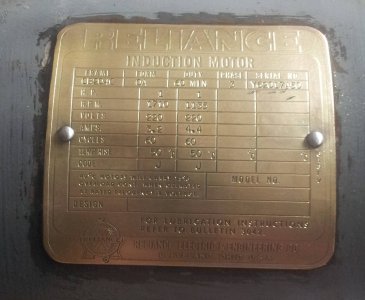- Joined
- Sep 3, 2012
- Messages
- 53
My Index 55 mill has a Reliance motor, 220 volts, 3 phase ,2 speed 1HP ( 1710 @ 3.2 amps, 1135 @ 4.4 amps) and is currently run of a static converter, that on occasion, does not always start the motor. I am going to convert to a VFD for 3 phase conversion and small speed ( fine tuning ) control of the motor. On another website a guy converted his Enco mill that had a 1.5 HP motor and replace with a 2 HP ( 6.8 amps 1725 rpm Inverter Duty ) motor but sized the VFD for 3 HP ( 10 amps output ) , I know you size the VFD by amps and not by HP .
My question is should I buy a VFD on the premise that my old motor will not last long ( unless I keep it in the 60 hz range ) for a future bigger size motor ( 1.5 to 2 HP inverter duty) motor that is not 2 speed but a 1725 rpm motor and size the amps on the VFD as such like the other guy did? I could buy a smaller VFD ( 1 HP model with 5 amps output ) or even a 2 HP model ( 8 amps ).
A couple of the reasons he upgraded to a 2 HP motor was more torque, he also kept the belt spindle pretty much 1 : 1 , he mentioned that most of his milling operations were kept at about 2550 rpm or below and by sizing the VFD for more amps than the new motor drew, he felt he would never tax the max output of the VFD drive.
does this sound reasonable?
also note the Reliance motor frame, CB 240 C, from what I can tell it and obsolete frame mounting, pre NEMA, So I am sure I'll have to make some sort of adapter plate for a new motor, but then that part of the fun. )
)

- Al

My question is should I buy a VFD on the premise that my old motor will not last long ( unless I keep it in the 60 hz range ) for a future bigger size motor ( 1.5 to 2 HP inverter duty) motor that is not 2 speed but a 1725 rpm motor and size the amps on the VFD as such like the other guy did? I could buy a smaller VFD ( 1 HP model with 5 amps output ) or even a 2 HP model ( 8 amps ).
A couple of the reasons he upgraded to a 2 HP motor was more torque, he also kept the belt spindle pretty much 1 : 1 , he mentioned that most of his milling operations were kept at about 2550 rpm or below and by sizing the VFD for more amps than the new motor drew, he felt he would never tax the max output of the VFD drive.
does this sound reasonable?
also note the Reliance motor frame, CB 240 C, from what I can tell it and obsolete frame mounting, pre NEMA, So I am sure I'll have to make some sort of adapter plate for a new motor, but then that part of the fun.

- Al


